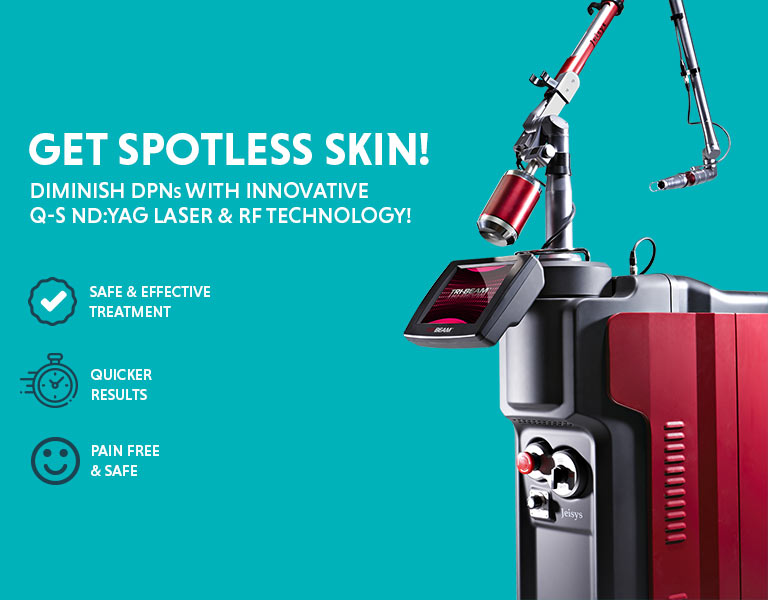Dermatosis Papulosa Nigra: Causes & Treatments
Highlights
- DPNs are harmless bumps on the skin. However, various methods for removal are available if desired for cosmetic reasons. Advanced treatments like laser therapy and electrocautery can help remove DPNs effectively and safely.
What Are DPNs On Skin?
Dermatosis papulosa nigra refers to tiny black or brown spots on the skin that usually develop in the areas surrounding the eyes and the cheekbones. These dark spots can also appear on other areas of the body, including the neck, chest, and back. Dermatosis Papulosa Nigra (DPN) is a common variant of Seborrheic Keratoses (SK). Even if left untreated, DPNs are harmless bumps on the skin.
- Appearance: – The spots may appear to be smooth, round and flat or hanging off the skin or slightly pedunculated resembling skin tags. The usual size of DPNs ranges from one to five millimetres.
- Who Gets This: – It affects people of darker skin and incidence is relatively higher in the population of African, American and Asian descent. The condition typically surfaces during puberty, but reports of DPN in children as young as three years old are also available. DPN is more common in women than in men.
- Common Symptoms: – They are asymptomatic, and there is no associated crusting, scaling or ulceration. However, DPNs are prone to irritation and inflammation if present in the areas of friction. DPN spots are commonly confused with “moles”.
A DPN is neither malignant nor a medical concern. However, it essential to understand what may be the reason for its occurrence. Read on to know the potential factors that may be causing DPNs.
What Causes DPN?
The exact causes of Dermatosis papulosa nigra are still unconfirmed. However, acceptable theories that explain potential causes include:
- Heredity Factor: Several studies show that positive family history may increase the chances of the occurrence of DPNs. Genetic propensity may be responsible for the appearance of DPNs as a mutated gene FGFR3 is present in DPN lesions.
- Ultraviolet Exposure: The dark spots appear primarily in regions exposed to ultraviolet radiation such as the head, neck and upper trunk.
- Ageing: DPNs may increase in number and size with an increase in age.
Diagnosis Of This Skin Condition
A dermatologist can diagnose DPN by clinically examining the appearance and distribution of the dark spots. Sometimes, he or she may do dermoscopy, which is a non-invasive diagnostic tool that can help distinguish DPN from similar pigmented lesions. Usually, no further diagnostic screenings or tests are necessary.
Only in the rarest of instances will a dermatologist recommend a biopsy. A tiny sample of the skin excised from the lesion may be put through a microscopic examination to check for the growth of malignant cells.
Are You At Risk?
The spots or lesions due to DPNs are harmless. However, if they are rapidly increasing in number or size, it is best to seek medical attention.
Individuals who are more prone to have DPNs include:
- Those of African – American descent and Asians with darker skin tones.
- Those who have a positive family history of the condition have a genetic propensity to develop DPNs.
How To Prevent DPN?
It is not possible to prevent dermatosis papulosa nigra if it appears due to genetic factor. However, the following measures might help:
- Limiting direct exposure to ultraviolet rays.
- Your dermatologist may advise the use of sunscreen having a minimum of SPF30 regularly every three hours. Application of sunscreen is advisable at least 15 minutes before stepping out in the sun. Ask your doctor to recommend one based on your skin type to stay sun-safe.
Do DIY Remedies Help?
It is advisable to not experiment with any home remedies as it may cause skin irritation and inflammation. Self-care methods used without an accurate diagnosis might worsen instead of improving the skin condition.
What's The Treatment Of DPN?
Trained dermatologists at Oliva Clinic can manage your DPN effectively. They specialise in removing DPNs by performing advanced medico-aesthetic procedures that include the following:
- Electrocautery or radiofrequency
- Laser Therapy using Long-pulsed Neodymium-doped Yttrium Aluminium Garnet or Nd:YAG lasers.
Your dermatologist will be able to suggest the apt treatment and skin-care depending on your skin type and the severity of your concern.
Prognosis
Dermatosis papulosa nigra is an asymptomatic and harmless skin condition. The skin concern does not have any adverse effect on the overall health condition. However, if you have DPNs, you may seek treatment primarily for aesthetic reasons.
Delivering World-class dermatology solutions is our mission! Redefining the quality of care is a passion!
How to get started? 




